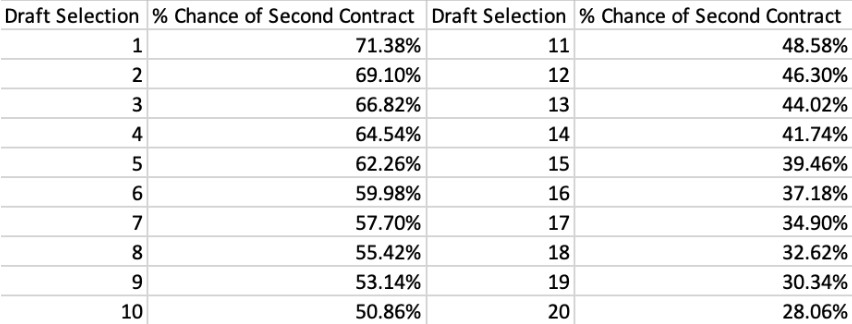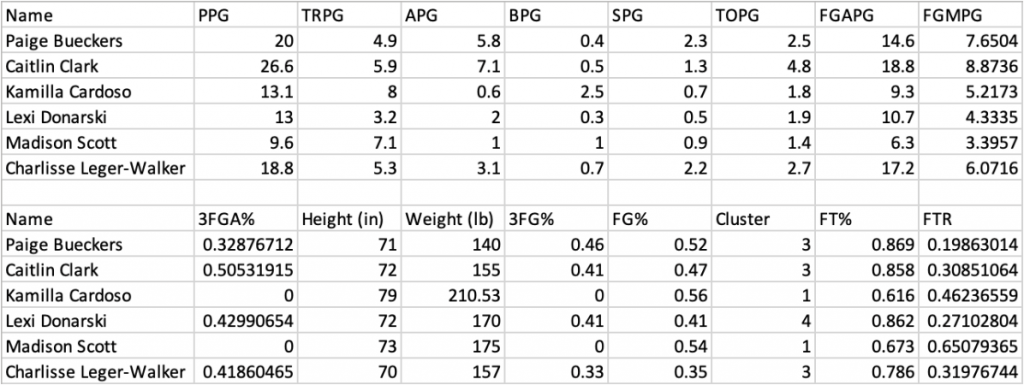By Davis Showell – Syracuse University ’21
Abstract
Currently, the WNBA requires draft entrants to be at least 22 years old when the draft takes place, basically requiring prospects to complete four years of college before entering the draft. This is contrary to the NBA, which only requires players to be one year removed from high school (this rule is often called the one-and-done rule). This research looks to analyze if the WNBA choosing to adopt the NBA’s one-and-done rule would be beneficial for WNBA prospects.
To determine if applying the one-and-done rule would benefit WNBA prospects, college basketball seasonal data was collected for WNBA players over 7 seasons. Cluster analysis was used to assign a position to each player. The position given by the cluster, along with other statistics, were then used in a draft model looking to project draft pick. Next, the odds of obtaining a second WNBA contract (and therefore a “successful” WNBA career) were calculated. Finally, the freshman player of the year winners for the six major basketball conferences were put into the cluster analysis and draft model to find their projected pick and subsequent odds of obtaining a second contract.
The results suggested that standout freshmen would benefit from the ability to leave college after one season. However, only very high-level prospects should leave due to low retention rates for draft picks outside the top portion of the draft.
Introduction
The popularity of women’s basketball has reached an all time high. The WNBA saw significant viewership spikes during their last season. It is important to make sure all assets to the league (like new talent) is being used as efficiently as possible. Ensuring the best women’s basketball players entire the league at the optimal time maximizes the benefit for the players (more time to earn wages, both playing and through endorsement deals), as well as the league (keeping the best players in the league for the longest amount of time in order to generate more fans, viewership, and ultimately revenue). While a college education is important backup, especially when potential players are looking to enter a relatively young and small market for players, it is possible star freshmen like Paige Bueckers of the University of Connecticut or Caitlin Clark of the University of Iowa are being hurt by the current rule requiring four years in college. The goal of this project is to find out if it would be beneficial for players like Clark or Bueckers to have the option to leave college early.
Method
Women’s college basketball statistics were scraped from Synergy Sports and included the box score summary statistics for every season played by a women’s basketball player in division 1 basketball from the 2012-2013 season through the 2018-2019 season. Pick information from every WNBA draft since 2011 was collected from basketball-reference.com. These two data sets were merged to form one master set containing every season of college basketball played by a WNBA draft pick from 2013-2019 along with where they were selected. Height and weight information was also scraped from basketball- reference. This data set finished with 600 total seasons.
Cluster analysis was used to group the players in the final data set in order to assign a positional factor to draft modeling to help the accuracy of said draft model. R package mclust was used to group players using scaled values of PPG, TRPG, APG, BPG, SPG, FGAPG, FGMPG, 3FGA%, player height, player weight, TOPG, and 3FG%. Four clusters were produces using this model: post players who do not shoot 3-point field goals (cluster 1), post players who do shoot 3-point field goals (cluster 2), high-usage guards (cluster 3), and low-usage guards (cluster 4).

Using the final college season for each player, the draft model was created. A linear regression with draft pick as the dependent variable. Independent variables included were PPG, TRPG, APG, SPG, BPG, FGAPG, FGMPG, TOPG, 3FG%, FT%, 3FGA%, and FTR.
Next, another linear regression was run to calculate the probability a WNBA draft pick signs a second contract based on where they were selected.

Results
In order to find out if a freshman entering the WNBA draft would be ”successful” (earn a second contract) in the league, six freshmen from the 2020-2021 were entered into the created models to predict their cluster, draft position, and subsequent odds of obtaining a second contract.
The freshmen chosen for modeling were selected because they were the winners of the “Freshman of the Year” award for their respective conferences. The winners of those awards were taken from the six major conferences: ACC, SEC, Big Ten, PAC 12, Big 12, and Big East. The players selected were Kamilla Cardoso (Syracuse), Madison Scott (Ole Miss), Caitlin Clark (Iowa), Charlisse Leger-Walker (Washington State), Lexi Donarski (Iowa State), and Paige Bueckers (Connecticut).

The freshmen were assigned clusters using the previously created cluster model, and the cluster they each fell into is listed in the figure above.
The newly clustered freshmen were then entered into the draft model and given a projected pick. This projected pick was then entered into the success model to give each player a percent chance of earning a second contract.

Due to inherent flaws in the modeling, it is likely that the odds of earning a second contracts were underpredicted. The modeling does not account for age, a huge factor when looking at basketball prospects (not included because all players drafted previously were roughly the same age). Younger players go higher in the draft, and if these players were to enter early, they would also be much younger at the time their rookie contracts expire, increasing the likelihood they would receive another offer.
Conclusions
This research aimed to identify if implementing the NBA’s one-and-done rule to the WNBA would be beneficial to the WNBA as well as the athletes looking to enter the draft. Based on the analysis done, it can be concluded top tier prospects would benefit from being able to leave college early. Prospects like Paige Bueckers and Caitlin Clark would go high enough in the draft to make it worth passing up a college degree for a WNBA salary, since it is likely they would obtain a second contract. Bueckers is also highly popular among basketball fans and on social media, and the endorsement money she could make capitalizing on this popularity would also contribute to financial security. Many WNBA players also play overseas during the WNBA off-season, which would also be an option for players of this caliber.
However, if you are going to be selected outside the top 10, it is probably not worth leaving early. The WNBA has very limited roster spots, making it difficult for players not selected early in the draft to retain a spot for multiple seasons. Players in this situation should stay in college and receive a degree so they can work after their playing career ends.
Acknowledgements
Thank you to Dr. Paul, my roommates Kushal Shah and Colin Krantz, and my parents for helping me through this process.
